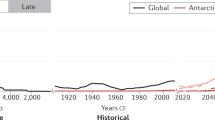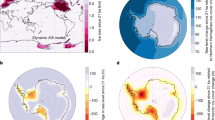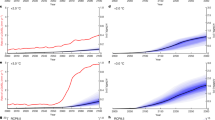Abstract
Large parts of the Antarctic ice sheet lying on bedrock below sea level may be vulnerable to marine-ice-sheet instability (MISI)1, a self-sustaining retreat of the grounding line triggered by oceanic or atmospheric changes. There is growing evidence2,3,4 that MISI may be underway throughout the Amundsen Sea embayment (ASE), which contains ice equivalent to more than a metre of global sea-level rise. If triggered in other regions5,6,7,8, the centennial to millennial contribution could be several metres. Physically plausible projections are challenging9: numerical models with sufficient spatial resolution to simulate grounding-line processes have been too computationally expensive2,3,10 to generate large ensembles for uncertainty assessment, and lower-resolution model projections11 rely on parameterizations that are only loosely constrained by present day changes. Here we project that the Antarctic ice sheet will contribute up to 30 cm sea-level equivalent by 2100 and 72 cm by 2200 (95% quantiles) where the ASE dominates. Our process-based, statistical approach gives skewed and complex probability distributions (single mode, 10 cm, at 2100; two modes, 49 cm and 6 cm, at 2200). The dependence of sliding on basal friction is a key unknown: nonlinear relationships favour higher contributions. Results are conditional on assessments of MISI risk on the basis of projected triggers under the climate scenario A1B (ref. 9), although sensitivity to these is limited by theoretical and topographical constraints on the rate and extent of ice loss. We find that contributions are restricted by a combination of these constraints, calibration with success in simulating observed ASE losses, and low assessed risk in some basins. Our assessment suggests that upper-bound estimates from low-resolution models and physical arguments9 (up to a metre by 2100 and around one and a half by 2200) are implausible under current understanding of physical mechanisms and potential triggers.
This is a preview of subscription content, access via your institution
Access options
Subscribe to this journal
Receive 51 print issues and online access
$199.00 per year
only $3.90 per issue
Buy this article
- Purchase on Springer Link
- Instant access to full article PDF
Prices may be subject to local taxes which are calculated during checkout



Similar content being viewed by others
References
Schoof, C. Ice sheet grounding line dynamics: steady states, stability, and hysteresis. J. Geophys. Res. 112, F03S28 (2007)
Favier, L. et al. Retreat of Pine Island Glacier controlled by marine ice-sheet instability. Nature Clim. Chang. 5, 1–5 (2014)
Joughin, I., Smith, B. E. & Medley, B. Marine ice sheet collapse potentially under way for the Thwaites Glacier Basin, West Antarctica. Science 344, 735–738 (2014)
Rignot, E., Mouginot, J., Morlighem, M., Seroussi, H. & Scheuchl, B. Widespread, rapid grounding line retreat of Pine Island, Thwaites, Smith, and Kohler glaciers, West Antarctica, from 1992 to 2011. Geophys. Res. Lett. 41, 3502–3509 (2014)
Mengel, M. & Levermann, A. Ice plug prevents irreversible discharge from East Antarctica. Nature Clim. Chang. 4, 451–455 (2014)
Hellmer, H. H., Kauker, F., Timmermann, R., Determann, J. & Rae, J. Twenty-first-century warming of a large Antarctic ice-shelf cavity by a redirected coastal current. Nature 485, 225–228 (2012)
Kuipers Munneke, P., Ligtenberg, S. R. M., Van den Broeke, M. R. & Vaughan, D. G. Firn air depletion as a precursor of Antarctic ice-shelf collapse. J. Glaciol. 60, 205–214 (2014)
Khazendar, A., Schodlok, M. P., Fenty, I., Ligtenberg, S. R. M., Rignot, E. & Van Den Broeke, M. R. Observed thinning of Totten Glacier is linked to coastal polynya variability. Nature Commun. 4, 2857 (2013)
Intergovernmental Panel on Climate Change. Working Group I Contribution to the IPCC Fifth Assessment Report Climate Change 2013: The Physical Science Basis (Cambridge Univ. Press, 2013)
Cornford, S. L. et al. Century-scale simulations of the response of the West Antarctic Ice Sheet to a warming climate. Cryosphere 9, 1579–1600 (2015)
Levermann, A. et al. Projecting Antarctic ice discharge using response functions from SeaRISE ice-sheet models. Earth Syst. Dynam. 5, 271–293 (2014)
Gudmundsson, G. H., Krug, J., Durand, G., Favier, L. & Gagliardini, O. The stability of grounding lines on retrograde slopes. Cryosphere 6, 1497–1505 (2012)
Joughin, I. et al. Basal conditions for Pine Island and Thwaites Glaciers, West Antarctica, determined using satellite and airborne data. J. Glaciol. 55, 245–257 (2009)
Joughin, I., Smith, B. E. & Holland, D. M. Sensitivity of 21st century sea level to ocean-induced thinning of Pine Island Glacier, Antarctica. Geophys. Res. Lett. 37, L20502 (2010)
Ritz, C., Rommeleare, V. & Dumas, C. Modeling the evolution of Antarctic ice sheet over the last 420,000 years: implications for altitude changes in the Vostok region. J. Geophys. Res. 106, 31943–31964 (2001)
Pritchard, H. D., Arthern, R. J., Vaughan, D. G. & Edwards, L. A. Extensive dynamic thinning on the margins of the Greenland and Antarctic ice sheets. Nature 461, 971–975 (2009)
Park, J. W. et al. Sustained retreat of the Pine Island Glacier. Geophys. Res. Lett. 40, 2137–2142 (2013)
Timmermann, R. & Hellmer, H. H. Southern Ocean warming and increased ice shelf basal melting in the twenty-first and twenty-second centuries based on coupled ice-ocean finite-element modelling. Ocean Dyn. 63, 1011–1026 (2013)
Ross, N. et al. Steep reverse bed slope at the grounding line of the Weddell Sea sector in West Antarctica. Nature Geosci. 5, 393–396 (2012)
Little, C. M., Oppenheimer, M. & Urban, N. M. Upper bounds on twenty-first-century Antarctic ice loss assessed using a probabilistic framework. Nature Clim. Chang. 3, 654–659 (2013)
Katsman, C. A. et al. Exploring high-end scenarios for local sea level rise to develop flood protection strategies for a low-lying delta—the Netherlands as an example. Clim. Change 109, 617–645 (2011)
Bamber, J. L. & Aspinall, W. P. An expert judgement assessment of future sea level rise from the ice sheets. Nature Clim. Chang. 3, 424–427 (2013)
Pollard, D., Deconto, R. M. & Alley, R. B. Potential Antarctic Ice Sheet retreat driven by hydrofracturing and ice cliff failure. Earth Planet. Sci. Lett. 412, 112–121 (2015)
Le Brocq, A. M., Payne, A. J. & Vieli, A. An improved Antarctic dataset for high resolution numerical ice sheet models (ALBMAP v1). Earth Syst. Sci. Data 2, 247–260 (2010)
Acknowledgements
This work was supported by the ice2sea project funded by the European Commission’s 7th Framework Programme through grant number 226375 (ice2sea contribution number ice2sea119), the UK National Centre for Earth Observation, NERC iGlass project, NERC and UK Met Office Joint Weather and Climate Research Programme, and the French National Research Agency (ANR) under the SUMER (Blanc SIMI 6) 2012 project ANR-12-BS06-0018. Most of the computations were performed using the CIMENT infrastructure (https://ciment.ujf-grenoble.fr), which is supported by the Rhône-Alpes region (grant CPER07 13 CIRA; http://www.ci-ra.org). We thank A. Shepherd and M. McMillan for observational data, H. Hellmer and R. Timmerman for model projection data, D. Vaughan and H. Hellmer for discussions about retreat onset, and J. C. Rougier for discussions about experimental design and calibration.
Author information
Authors and Affiliations
Contributions
C.R. and V.P. worked on the development of the GRISLI model and did the numerical modelling. C.R. and G.D., with contributions from T.L.E., performed the physics analysis. T.L.E. designed the experiments with contributions from all authors, wrote the manuscript with contributions from C.R. and G.D., and performed the statistical analysis. T.L.E. and C.R. produced the figures and animation, with contributions from G.D. The sampling and geostatistical analysis were produced by A.J.P., and the theoretical conditions of grounding-line retreat were developed by R.A.H., C.R. and G.D.
Corresponding author
Ethics declarations
Competing interests
The authors declare no competing financial interests.
Extended data figures and tables
Extended Data Figure 1 Grounding-line retreat parameterization.
a, Cumulative probability distributions of MISI onset for 14 basins (Fig. 1) aggregated into 11 independent sectors. b, Piecewise linear parameterization prescribing the dependence of grounding-line retreat rate on the logarithm of the effective basal friction coefficient (Extended Data Fig. 2). Each of the 1,000 functional forms is a variant used in the ensemble; a subset are shown in bold as examples. See also Supplementary Information, sections 1.6.1, 1.6.2.
Extended Data Figure 2 Initialization and basal friction evolution.
a–c, Initial values of the difference between simulated and observed surface elevation (a); velocities averaged over ice thickness (b); the logarithm of the initial effective basal friction coefficient, α = log10(β1′ (x; t = t0)) (c). d, As for c, showing the ASE. e, As for d, at 2200 in the plastic sliding law ensemble member that best matches present day ASE observations. See also Supplementary Information, section 1.5.
Extended Data Figure 3 Projected grounding-line retreat and initial basal friction.
a, b, Initial grounding line and map of α values (Extended Data Fig. 2) with retreat probability contours at 2200 for the Weddell Sea sector (a) and ASE (b): for example, there is an estimated 33% probability that grounding-line retreat will be less extensive than the 66% contour.
Extended Data Figure 4 Ice dynamical conditions for retreat.
a–c, Surface elevation changes at 2200 in the ensemble member with maximum sea-level contribution at 2200 (plastic sliding law): standard settings (a); ‘Schoof flux’ condition off, thereby only allowing grounding-line retreat along strictly downsloping bedrock (b); ‘no suction’ check off, thereby allowing thinning due to grounding line retreat to occur faster than the theoretical limit (c). See also Supplementary Information, section 2.2.1.
Extended Data Figure 5 Relationship between present and future sea-level contributions from the Amundsen Sea.
a, b, Dynamic mass losses in cm sea-level equivalent from the ASE at 2100 (a) and 2200 (b), as a function of present day mass loss in the same region. The branches arise from interactions between basal drag coefficient and friction law that produce different rates of, and impediments to, grounding-line retreat. The observed mass loss is shown, along with observational (± 3σo) and total (± 3σt) uncertainties (Supplementary Information, section 1.7).
Extended Data Figure 6 Contributions of each basal friction law.
a, b, Probability distributions of Antarctic dynamic mass losses in cm sea-level equivalent at 2100 (a) and 2200 (b) (as in Fig. 2b), showing the cumulative contributions of the basal friction laws.
Extended Data Figure 7 Uncalibrated projections.
a–h, Prior (uncalibrated) projections of Antarctic dynamic mass losses in cm sea-level equivalent (a–d); rate of ASE dynamic mass losses in mm yr−1 sea-level equivalent (SLE) (e–h). Posterior (calibrated) projections are in Figs 2 and 3. See also Supplementary Information, section 1.7.
Extended Data Figure 8 Parameter calibration and influence.
a, b, Weights for each of the 1,000 sub-ensemble parameter sets (averaged over basal friction laws) as a function of low threshold of effective basal drag coefficient (αlow) and maximum retreat rate (vmax) (a); bedrock map index and high threshold of effective basal drag coefficient (αhigh) (b). Darker colours indicate values favoured by observational calibration. c, d, Uncalibrated dynamic mass losses at 2200 in cm sea-level equivalent (SLE) as functions of the same.
Extended Data Figure 9 Sensitivity to retreat onset distributions.
a–d, Projections at 2200 estimated for four individual basins under different retreat onset scenarios. a, ASE: original; ‘probability × 0.8’, in which 20% of simulations are set to zero contribution; ‘late retreat’, in which all simulations begin retreating between 2020 and 2030; and ‘early retreat’, retreating between 2000 and 2010; b, Shackleton; c, Siple Coast; and d, Transantarctic Mountains: original, and onset probabilities adjusted by the factors shown. See also Supplementary Information, section 2.2.2.
Extended Data Figure 10 Sensitivity tests for plastic sliding law.
Antarctic dynamic mass losses in cm sea-level equivalent under various conditions: ‘Max likelihood’, the plastic simulation that best matches present day ASE observations; ‘Uncalib 95%’ and ‘Calib 95%’, the plastic quantiles before and after calibration, respectively, and ‘Calib ASE 95%’, the estimate calibrating only the ASE; ‘Ensemble max’, the simulation with highest contribution at 2200; ‘Extreme onset’, the previous with all basins retreating from 2000 or 2020; ‘Max params’, the previous with retreat parameters at maximum values and ‘Extreme params’ at higher values; ‘Schoof flux’ and ‘No suction’ checks off (dashed to indicate that they are physically unrealistic). See also Supplementary Information, sections 2.2, 2.3.
Supplementary information
Supplementary Information
This file contains Supplementary Methods, a Supplementary Discussion, Supplementary Data information and additional references. (PDF 788 kb)
Supplementary Table
This file contains sea level projections. (XLS 419 kb)
Supplementary Data
This zipped file contains R script and data: projections. The Code to output annual Antarctic posterior projections as the following options: modes (cm SLE), quantiles (cm SLE) or probabilities of non-exceedance (%) for any quantile/threshold and date range. These results correspond to the columns ‘Prob’ (probabilities of non-exceedance) and ‘SLE’ (modes, quantiles) for rows ‘ALL ANT Post’ in the Excel file, but using this script any quantile/threshold and year may be chosen. (ZIP 9088 kb)
Animation of the Amundsen Sea Embayment
Summary of the projections in ten-year time steps. The black contour shows the projected median grounding line position. The map shows the mean change in surface elevation, with -100 m contour shown in green. Dashed purple lines show the borders of Pine Island Glacier (PIG) and Thwaites Glacier, which together comprise the Amundsen Sea Embayment. (MP4 2643 kb)
Rights and permissions
About this article
Cite this article
Ritz, C., Edwards, T., Durand, G. et al. Potential sea-level rise from Antarctic ice-sheet instability constrained by observations. Nature 528, 115–118 (2015). https://doi.org/10.1038/nature16147
Received:
Accepted:
Published:
Issue Date:
DOI: https://doi.org/10.1038/nature16147
This article is cited by
-
Icequakes used to measure friction and slip at a glacier bed
Nature Geoscience (2023)
-
Highly variable friction and slip observed at Antarctic ice stream bed
Nature Geoscience (2023)
-
Contrasted influence of climate modes teleconnections to the interannual variability of coastal sea level components–implications for statistical forecasts
Climate Dynamics (2023)
-
Mass Balances of the Antarctic and Greenland Ice Sheets Monitored from Space
Surveys in Geophysics (2023)
-
Threshold response to melt drives large-scale bed weakening in Greenland
Nature (2022)
Comments
By submitting a comment you agree to abide by our Terms and Community Guidelines. If you find something abusive or that does not comply with our terms or guidelines please flag it as inappropriate.



